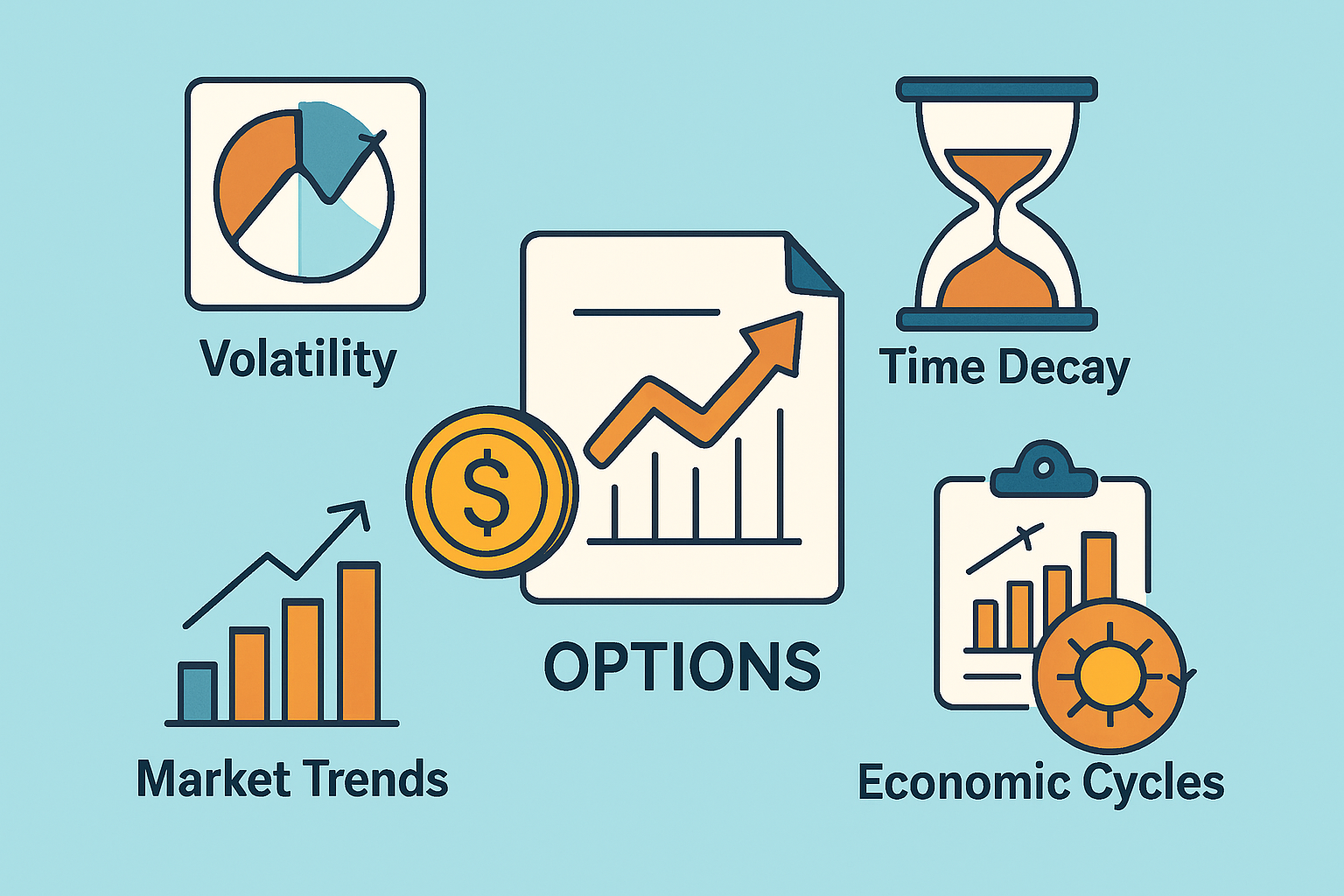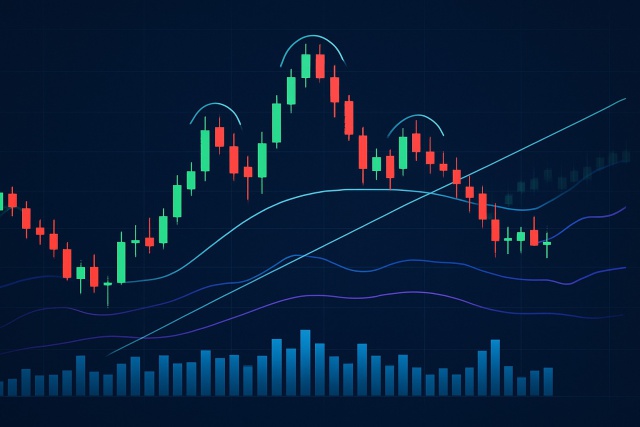
How trading options on futures works?
Explore how trading options on futures can diversify your portfolio and manage risk with leverage. T...

Commodity options trading is a versatile derivative strategy that gives traders the right but not the obligation to buy or sell specific commodity futures contracts at predetermined prices. It holds a solid spot in futures trading by offering flexible opportunities to profit, manage risk and hedge positions. With the right know-how and a smart plan, commodity options let traders ride market swings while keeping potential losses in check.
Commodity options grant traders the right to buy (call options) or sell (put options) an underlying commodity futures contract at a predetermined strike price anytime before or on the expiration date. The option's price, known as the premium, captures both its intrinsic and time value—factors influenced by market volatility and time left until expiration.
Traders jump into the fray buying and selling options contracts on commodity exchanges, coughing up premiums that usually mirror supply and demand, the price of the underlying asset, market jitteriness, and the ticking clock. Leverage lets traders control hefty amounts of commodities without needing a fortune upfront. Margins act like a safety net to make sure everyone holds up their end of the bargain.
| Attribute | Description | Impact on Trader's Profit/Loss |
|---|---|---|
| Strike Price | The price at which you can buy or sell the underlying commodity contract | This one calls the shots on whether your option is in or out of the money, directly influencing your potential payday or pain |
| Expiration Date | The last day to exercise the option | Think of this as the ticking clock; options nearing expiry tend to lose their time value faster, adding a bit of urgency to your decisions |
| Premium | The cost paid to acquire the option | The price of admission here—representing the max you stand to lose if things don’t pan out and your option expires worthless |
| Intrinsic Value | The current value if the option was exercised right now | Shows the immediate gain when your option is basking in-the-money at exercise |
| Time Value | The extra premium based on time left until expiration | This value slips away as the clock ticks on, sometimes causing losses even if intrinsic value is still holding strong |
| Leverage | Ability to control a larger position with a smaller amount of capital | Packs a punch—boosting both your profit chances and risks; just keep an eye on margin rules |
| Volatility | The extent of price fluctuations in the underlying commodity | The wild card that usually drives premiums up and shapes your risk and reward landscape |
Diving into the world of commodity options can feel like stepping into a whirlwind. On the bright side, these options offer a unique way to hedge against market swings and even open doors to some attractive profit opportunities. That said, don’t be fooled into thinking it’s a walk in the park; the risks can sneak up on you if you’re not careful. So, whether you are a seasoned trader or just dipping your toes in, understanding both the upsides and the pitfalls is key to navigating the choppy waters of commodity options trading.
Commodity options offer a neat blend of leverage, flexible positioning and limited downside risk making them a solid choice for both hedging and a bit of speculation. Traders have to keep an eye on some tricky pitfalls like time decay quietly eating away at an option's value and unexpected jolts in commodity prices. Understanding various pricing factors is also a challenging task.
Successful commodity options trading often hinges on picking strategies that not only match the current market mood but also sit comfortably with your own risk tolerance. The usual playbook includes directional trades—think buying calls or puts—spreads that cleverly exploit price gaps and volatility shifts, and hedging tactics meant to shield your existing commodity positions from nasty surprises.
Buying calls or puts to speculate on whether commodity prices will climb or take a nosedive.
Covered calls, where you already own the commodity or futures and sell call options to pocket some extra income on the side.
Protective puts act like a safety net—buying puts to help cap losses on the commodities sitting in your portfolio.
Vertical spreads involve simultaneously buying and selling options of the same type but at different strike prices, giving you a way to keep risk in check while aiming for a decent payoff.
Calendar spreads are a clever tactic that plays on the difference in prices between options expiring sooner and those with a later expiration date.
Straddles and strangles profit when the market’s throwing a tantrum—capitalizing on high volatility regardless of which way prices swing.
Ratio spreads are a bit more sophisticated, using an uneven number of options to juggle risk and shoot for bigger potential rewards.
When it comes to directional trading, having a game plan is key. Whether you’re riding the wave up or bracing for the dip, these strategies can help you stay on course and avoid getting caught off guard.
Directional trading is all about trying to cash in on expected price moves in commodities. When you’re betting on prices going up, buying call options can be a neat trick it gives you some nice leverage while keeping your downside in check. On the flip side, snapping up put options can really pay off if you’re anticipating prices will fall.
Spread strategies involve buying and selling commodity options together to balance risk and reward. Vertical spreads limit both potential losses and gains by using different strike prices. Calendar spreads take advantage of time decay and shifts in volatility between near-term and longer-term options, capturing market mood swings at the right moments. Ratio spreads adjust your exposure to volatility and directional risk by using uneven numbers of options, adding a twist to the usual playbook.
| Strategy | Setup | Risk Level | Profit Potential | Best Market Condition |
|---|---|---|---|---|
| Vertical Spread | Buy and sell calls or puts that share the same expiry but have different strike prices | Carries moderate risk with capped returns, so you know your upside is limited but safe | Gains are modest and clearly defined—no surprises here | Best suited for markets that trend steadily, where you can get into a rhythm |
| Calendar Spread | Purchase a long-term option and sell a short-term option at the same strike price | Usually low to moderate risk, which makes it a nice, gentler approach | Profits come from time decay and volatility shifts—patience pays off here | Loves stable to gently twitchy markets, where things aren’t too wild but not totally dull |
| Ratio Spread | Buy fewer options and sell more at different strike prices | Higher risk due to uncovered options, so hold onto your hat | Can bring bigger rewards if the market swings your way | Prefers volatile markets that have a clear direction—nothing boring about this one |
Commodity producers, consumers and investors often lean on options to soften the blow from price swings. Protective puts act like a safety net and grant holders the right to sell at predetermined prices if the market takes a nosedive. Covered calls offer a neat way to earn a little extra on owned commodities by selling call options and can help chip away at the overall cost.
Hedging with options isn’t about raking in profits on every single trade; instead, it’s more like putting a safety net under your hard-earned gains. When you use protective puts and covered calls thoughtfully, they often act as a buffer against those unexpected jolts in commodity prices, all while quietly opening doors for some savvy, strategic income. – Jane Foster, Commodity Trading Expert
Profitability in commodity options trading often boils down to a few key ingredients. Volatility is a big one because it directly impacts option premiums. Time decay quietly chips away at option value as the clock ticks. Market trends also hold plenty of sway. The broader macroeconomic backdrop includes geopolitical happenings and the shifting supply and demand landscape.

Visual infographic illustrating critical factors that impact commodity options trading profitability
Building a personalized trading plan is important to succeeding in commodity options trading. Start by honestly assessing how much risk you can stomach and setting profit targets that make sense for you. Stick to commodity markets you’re familiar with because there’s no point in flying blind. Set clear rules for when to jump into trades and when to get out. Manage your capital with care, choose option strategies thoughtfully and don’t forget to put risk controls in place with stop-loss and take-profit orders.
Be brutally honest with yourself about your risk tolerance. Knowing exactly how much capital you can comfortably lose without breaking a sweat is half the battle.
Stick to commodity markets you either know inside out or have done your homework on because winging it rarely plays out well.
Nail down clear entry and exit rules that blend both technical signals and fundamental insights. No guessing games here.
Break up your trading capital into bite-sized, manageable chunks so you’re not putting all your eggs in one basket.
Choose options strategies that truly mesh with your market outlook and how much risk you’re okay with. There’s no point in biting off more than you can chew.
Always set stop-loss and take-profit levels to protect your hard-earned gains and keep potential losses in check.
Make it a habit to regularly review and analyze your trades because it’s the best way to pick up insights and sharpen your strategy as you go along.
New commodity options traders often find themselves biting off more than they can chew—overleveraging and brushing past the sneaky effects of time decay. They choose strategies that just don’t quite click and let their emotions run the show. These missteps can burn through capital faster than you would like and put a serious dent in performance.
"A classic stumble I see with new options traders is chasing those quick wins without having a solid plan in place. Truth be told, keeping your discipline and sticking to well-worn, reliable strategies usually pays off better in the long run when it comes to commodity options." – Michael Chen, Veteran Commodity Trader
To really sharpen your skills in commodity options trading, having solid educational resources and cutting-edge trading platforms in your corner is super important. Supportive communities also help a lot. Tools like analytical charts, options pricing calculators, up-to-the-minute market data, comprehensive training materials and lively forums can take the hassle out of learning and executing trades.
Struggling to improve your trading performance? Edgewonk's advanced analytics tools are designed to give you the edge you need.
With detailed trade journaling, robust strategy analysis, and psychological insights, you'll gain a comprehensive understanding of your strengths and weaknesses. Don't miss out on this game-changing opportunity.
Traders, it's time to elevate your game. Edgewonk is the ultimate trading journal software designed to empower you with data-driven insights and personalized strategies. Take control of your trading journey and maximize your potential.
10 posts written
Combining cutting-edge mathematical models with a deep understanding of market dynamics, Shion Tanaka has revolutionized algorithmic trading strategies, yielding unprecedented returns for global financial institutions.
Read Articles
Explore how trading options on futures can diversify your portfolio and manage risk with leverage. T...

Futures options blend flexibility and risk management in futures trading. This guide breaks down the...

Unlock the power of the head and shoulders pattern with this complete guide. Learn to spot, trade, a...

Discover what IOUs mean in finance, their role as informal debt acknowledgments, and how understandi...
